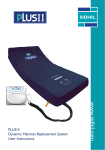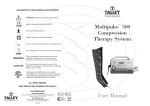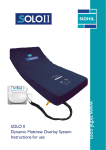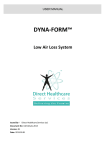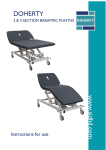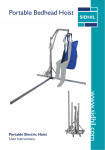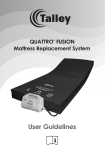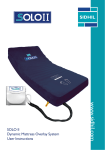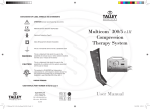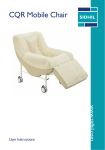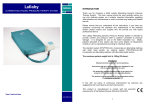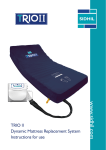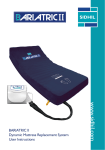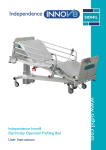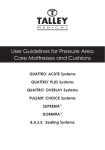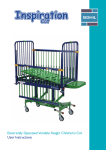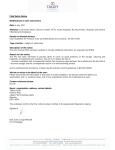Download - Arden Care Supplies Ltd
Transcript
Serenade Lite Dynamic Cushion System User Instructions CONTENTS Important Notice Before operating this medical equipment, it is important to read this manual and understand the operating instructions and safety precautions. Failure to do so could result in injury and/or damage to the product. If you have any questions, please see contact information on rear cover. INTRODUCTION.........................................3 SAFETY PRECAUTIONS.................................4 PRODUCT OVERVIEW....................................5 INSTALLATION................................................6 OPERATION.....................................................8 Control Unit Panel......................................8 Establishing Pressure.................................9 Use of Incontinence Products..................10 Static Mode..............................................10 Removal & Transport Function.................11 Mains Supply Power Failure.....................11 TROUBLESHOOTING...................................12 CLEANING.....................................................13 MAINTENANCE.............................................14 TECHNICAL SPECIFICATION.......................15 WARRANTY INFORMATION.........................21 2 INTRODUCTION Serenade Lite Dynamic Cushion System Thank you for choosing a Serenade Lite Analogue Dynamic Cushion System. This user manual should be read carefully before using the cushion and control unit as it contains important information regarding safe operation and maintenance in order to provide long lasting and reliable service. Please ensure that you understand all the instructions, if you have any questions concerning the operation and maintenance of the system please contact your supplier who will provide you with expert professional advice. Serenade Lite Cushion System The box contains an assembled cushion system consisting of: A. B. C. D. Serenade Lite Alternating Seat Cushion (including air hoses). Analogue Control Unit Mains Cable User Manual 3 SAFETY PRECAUTIONS In General Control Unit Do not use this equipment in the presence of flammable anaesthetics. The Serenade Lite cushion is supplied with an analogue control unit. The cushion is only compatible with the analogue system, and is not compatible with digital control units. Keep away from sources of heat and naked flames Chairs used with the system can vary greatly depending on the specific health care setting (i.e. hospitals, nursing homes, home care etc). It is the responsibility of the carer to carry out the necessary risk assessments to ensure the safety of the patient. The control unit is tested and CE marked in line with Medical Device Directive (93/42/EEC). Only plug into a mains socket using the mains cable supplied with the system. Exposure of the control unit to any liquid while it is plugged in could result in a severe electrical hazard. Do not use on movable chairs / wheelchairs Minimise articles between the cushion surface and patient, so as not to affect the alternating cell movement. Only use fuses that have the same specified rating. Using fuses with higher ratings could result in damage and/or injury. (See Technical Specification) The control unit is a precision electronic product. Use care when handling or transporting. Dropping or other sudden impacts may result in damage to the unit. Do not open the control unit – risk of electrical shock. Do not attempt to repair or service the control unit. Repairs and service should be conducted by suitably trained personnel. If the control unit is not functioning properly, or has been damaged, unplug the unit and take it out of service immediately (see contact information on rear cover for repair and service information). Do not place any objects or items, such as blankets, on or over the control unit. The mains cable to the control unit should be correctly positioned to avoid a tripping hazard and/or damage to the cable. It is recommended to place the cable to the rear of the chair, and attach it to a mains socket by the rear of the chair. 4 PRODUCT OVERVIEW Alternating Seat Cushion System (see Technical Specification) Control Unit The Serenade Lite Dynamic Cushion System is intended to provide comfort and pressure relief to patients vulnerable to pressure damage. It is designed for use on static chairs only. Ideally, patients allocated to this system will have some degree of independent mobility or can be repositioned according to individual needs. The control unit provides the air supply to the cushion. • It is operated via a control panel with integrated analogue display. A warning light illuminates when low pressure is detected or when power is interrupted. The light will remain illuminated until the fault is rectified. • Functions on the control panel enable patient comfort level to be adjusted, as well as setting the cushion to static or alternating mode. The maximum patient weight limit is 110kg (17 Stone). Dynamic Seat Cushion If the mains cable becomes detached the alternation sequence is suspended and the cushion cells remain inflated and/or deflated based on the current cycle. The warning light will illuminate. This Serenade Lite system includes two layers of seven cells. The bottom cells and the front cell in the top layer are static to provide static support for optimum user comfort, while air pressure in the other cells is alternated over a twelve minute cycle. In alternating mode this provides regular periods of pressure reduction to aid blood and lymphatic flow to vulnerable tissue. 5 INSTALLATION Any damage or missing components should be reported to your supplier as soon as possible. System Installation Control Unit Activation The following describes the procedures for initial system set up: a. If possible, remove the existing seat cushion so that the correct height is preserved. a. Position the control unit by hanging the hooks over the seat back or place unit on the floor at the rear of, or under the chair with the front facing upwards. Ensure the rear of the unit is not obstructed by carpet, rugs etc. It is advisable to place the unit on a firm surface. b. Position the cushion on top of the chair seat section, top cover (printed side) facing upwards and air hoses at the rear corner of the seat for control unit positioning. b. Attach the air connectors to the control unit. Ensure air hoses do not kink. c. To avoid any risk of damage to the seat cushion ensure there are no sharp objects which may come in contact with it. c. Insert mains cable into the control unit, plug into a mains socket. Ensure the cushion is in the correct orientation. Do not place the seat cushion in a wide chair without inserting side buffers to prevent the patient slipping between the cushion and side arms. d. Switch on the green power switch to activate the control unit, and turn the dial up to maximum to commence inflation. A light will illuminate indicating the system has activated. Allow up to ten minutes for full inflation. e. When initial inflation is complete adjust pressure setting and alternating/static mode based on patient requirements. 6 INSTALLATION To attach the air hoses to the control unit: Align the male air hose fixing (1) with the female port on the control box (2). Push the air hose into the port, it should ‘click’ into place. Follow the above procedure to attach the female air hose fixing (3) to the male port on the control box (4). To remove the air hoses from the control unit: The female port on the control box (2) and the female air hose fixing (3) have a grey section that can be depressed to release the hose. Depress the grey section on the female control box port (2), whilst gently pulling the male air hose (1) away from the control box. The air hose will detach from the control box. Follow the above procedure to remove the female air hose fixing (3) from the male port on the control box (4). 7 OPERATION Control Unit Panel A - Static Mode Indicator B - Warning Indicator C - Power Indicator D - Power On/Off Switch E - Pressure Adjusting Dial F - Alternating/ Static Switch A Static Mode Indicator The static indicator light will illuminate when static mode is selected (using the alternating/static switch). The light will extinguish when the system is manually switched over to alternating (graphic shows switch in static position). B Warning Indicator The warning light will illuminate when a fault condition has arisen in the control unit or cushion. C Power Indicator When the control box is connected to mains supply (and turned on using the power on/off switch) the power indicator will illuminate. D Power On/Off Switch Pressing the on/off switch (with the control box connected to mains supply) turns the control unit on or off. E Pressure Adjusting Dial The dial can be rotated clockwise or anticlockwise to increase or decrease the pressure setting. Pressure setting can be adjusted from soft to firm (30mmHg to 60mmHg). F Alternating/Static Switch Selecting alternating mode using the switch cyclically inflates and deflates the cells in sequence. Selecting static mode fully inflates all cells with no dynamic alternation. This analogue system will not revert back to alternating mode unless it is manually switched back over. 8 OPERATION Seat Cushion Function Establishing Pressure Establishing pressure when moving from a mattress to a cushion With the patient sitting upright on the cushion, use the pressure adjusting dial to establish the best setting for effective support and comfort. When moving the patient from a mattress to a cushion, the pressure may need to be increased to provide added support and to avoid bottoming out. Before changing or lowering the pressure, ensure the system is working effectively. It is important to return to the original pressure setting on the mattress control unit when the patient returns to the mattress. Once the system has been set for the patient, re-check after approximately 20-30 minutes to ensure the patient is comfortable and that the unit is functioning correctly. Wait a minimum of twelve minutes between pressure adjustment and patient assessment; it may take a full cycle for the system to adjust. A patient assessment must be performed after seat cushion inflation. 9 OPERATION Use of Incontinence Products Static Mode Incontinence products such as seat covers, sheets or pads can be used with this system. However, product performance is likely to reduce due to the patient experiencing less pressure relief when using these aids. The system has the capability to operate as a static cushion. This function enables nursing staff to carry out procedures on a static support surface and/or may be selected if a patient is finding it difficult to tolerate alternating mode. (This could occur if, for example, the patient is in pain or nauseated). If incontinence products are to be used it is recommended that regular patient skin checks are performed to ensure skin integrity is maintained. When static is selected all cells inflate at the pressure at which the cushion is set, thereby offering a non moving surface. This analogue system will not return to alternating mode automatically, it has to be manually switched back over. To select static mode press the alternating/ static switch, the static mode indicator will illuminate. The pressure can be adjusted to suit using the pressure adjustment dial on the front of the control unit. The pressure should be reduced when using the static mode to check for a patient’s suitability to tolerate a static surface. Regular patient skin checks should be performed to ensure that a static support surface can be tolerated. Ideally patients should remain on a static support surface for no more than two hours without undergoing a thorough skin check. If the patient cannot tolerate static mode the system should be reverted to dynamic therapy by changing the alternating/static switch to alternating. The static mode indicator will extinguish. 10 OPERATION System Removal Mains Supply Power Failure 1. Turn off the control unit by pressing the power switch, and unplug the mains cable. 2. To deflate the Serenade Lite, detach the air pipes from the control box, unzip the umbilical cord sleeve and open the connector. 3. Place the control unit and mains cable on top of the seat cushion and remove it from the chair. If it is known that there is to be a power cut in advance, follow the instructions detailed under the heading ‘Transport Function’ prior to the power going off. In the event of an unplanned power cut: 1. Remove the air connectors from the control unit and connect together (as shown in ‘Transport Function’) 2. Turn off the control unit. Transport Function 1. Before preparing product for transport, switch mode from alternating to static, and wait for twelve minutes for all cells to inflate. 2. Remove the air connectors from the control unit, and connect together (see image below). 3. Turn off the control unit. Seat cushion will stay inflated under normal conditions for up to 12 hours. 11 TROUBLESHOOTING Alarm/Fault Cause Control unit does not operate; power indicator light does not illuminate. The control unit may not be attached to a power socket, or a fuse may need replacing. Solution 1. Check the control unit is connected to mains socket with the correct voltage. Check the mains power is switched on (to ensure socket is working plug in a lamp or other fused electrical device). 2. Check the control unit is switched on. 3. Check the mains plug fuse (13A) and then check control unit fuse (1A) – see ‘Maintenance’ section. Do not try to open the control unit. Opening the unit could cause personal injury or equipment damage. Warning indicator light illuminates Power down. Fault condition in cushion or control box. 1. Check the air hoses are intact, ensuring both sealing connectors are firmly fitted to the control unit and the air hoses. 2. Check all air hoses along the inside of the cushion and air hose sleeve – each should be firmly connected. Check each air cell is securely attached to its connecting air pipe. 3. Check all cells, pipes and hoses for any air leakage/kinks. 4. Switch on power. 1. Check the mains cable is firmly plugged into a wall socket and the control unit. Check the mains power is switched on (to ensure socket is working plug in a lamp or other fused electrical device). Check 13A fuse. 2. Check the control unit fuse (1A) – fuse can be released using a screwdriver to push and turn – ensure power supply is switched off. If the above actions fail to rectify the problem please contact your local authorised service provider or Sidhil Limited. 12 CLEANING Infection Control Wipe down with a disposable soft cloth moistened with a mild detergent and diluted in warm water (40°C), dry thoroughly before use. Routine cleaning for infection control must be carried out in accordance with your local infection control policy or regulatory body. Wipe down with a solution of Sodium Hypochlorite or similar (up to 1,000ppm Chlorine), dry thoroughly before use. Cleaning the Control Unit Disconnect the mains cable from the power socket before attempting to clean the control unit. In extreme cases 10,000ppm Chlorine can be used but the following process must be adhered to: 1) Wipe cover down using cold water 2) Clean with Chlorine solution 3) Wipe cover again using cold water. Do not immerse the control unit in water. Ensure the mains cable and control unit are dry before use. The top cover may also be decontaminated using Ethylene Oxide or the Draeger method. The control unit can be cleaned by wiping down with a damp cloth soaked in a sodium hypochlorite solution (1000 ppm available chlorine) and dried with a clean dry cloth. Additional infection control and routine cleaning must be carried out in accordance with your local infection control policy. Do not use Phenol based cleaning agents (e.g. Stericol, Hycoline, Clearsol etc.) The power unit is not IP rated therefore care should be taken to ensure only a damp cloth is used. Cushion Cover Cleaning Instructions. Cleaning the Cushion Machine wash at 71°C Before attempting to clean the cushion the top cover should be checked for physical signs of damage that may lead to strike-through (ingress of fluid through cover). This is achieved by unzipping the cover and looking for signs of staining to the white underside. Any evidence of strike-through will require a new cover to be fitted to the system. Do Not Iron Do Not Bleach Do Not Dry Clean The cover must not be reused if strikethrough is evident. Tumble Dry on Low Heat If the above washing instructions are not followed the warranty will be invalidated. 13 MAINTENANCE Only authorised service personnel or Sidhil service engineers should carry out repairs or service activities. Failure to do so may result in the product warranty becoming void. The seat cushion system must be serviced once yearly, as a minimum. Sidhil also recommends that the carer performs frequent visual and operational inspections. If there are any signs of damage or the system is not performing as it should withdraw it from service until the system has been repaired and is fit for use again. Air Filter Replacement Fuse Replacement – Control Unit See service manual for control unit air filter maintenance and replacement. 1. Switch off the power supply to the control unit. Good filter maintenance is critical to maintain an optimal operating system. Failure to keep the filters clean will result in system downtime and increase repair costs. It is recommended that the air filter be replaced annually. Replacement air filters are available; please see contact information on rear cover. 2. Remove the mains cable from the control unit. 3. Insert a small flat head screwdriver into the groove in the fuse holder, and turn anti- clockwise (quarter turn). 4. Remove the used fuse from the fuse holder clip and discard. 5. Insert a new fuse into the fuse holder clip. Push fuse holder into the control unit against the force of the spring and turn clockwise with the screwdriver (quarter turn). 14 TECHNICAL SPECIFICATION Serenade Lite Control System Analogue controller Compatible Control Units Serenade Lite Only Cycle Time 12 minutes Supply Voltage 220-240V, 50Hz 0.2A for Control Unit Fuse Rating Mains plug – 13A (x1) Control unit – 1A (x1) Power Rating Standards Number of Cells 12VA CE marked in line with Medical Devices Directive (93/42/EEC) 14 cells which includes: 8 static cells (7 in bottom layer, 1 at the front of the top layer) 6 alternating cells Cell Height 100mm Alternating Therapy AB pattern Maximum Patient Weight 110kg 17 Stone Cushion Dimensions Length: 430mm ± 20mm Width: 430mm ± 20mm Height: 105mm ± 10mm Weight: 1.4kgs Control Unit Dimensions Height: 275mm Width: 170mm Depth: 120mm Weight: 2kgs Cell Material Pure TPU Base Material 420D PA/TPU Cover Material Biocompatible PU/knitted PES, two way stretch, 195 g/m2 Hose Connection Operating (Storage/Transport) Environment Push on air pipes Air humidity 30% to 75% (10% to 70%) Ambient temperature 10°C to 40°C (-10°C to 60°C) 15 TECHNICAL SPECIFICATION Definition of Symbols Used The following symbols may appear in this manual, on the control unit, or on its accessories. Some of the symbols represent standards and compliances associated with the control unit and its use. Caution, consult accompanying documents Class II equipment Manufacturer Serial number Type B applied part DISPOSAL: Do not dispose of this product as unsorted municipal waste. Collection of such waste separately for special treatment is necessary. 16 TECHNICAL SPECIFICATION Declaration – electromagnetic emissions- for all ME EQUIPMENT and ME SYSTEMS Guidance and manufacture’s declaration – electromagnetic emission The Serenade Lite is intended for use in the electromagnetic environment specified below. The customer or the user of the Serenade Lite should ensure that it is used in such an environment. Emission test Compliance Electromagnetic environment – guidance RF emissions CISPR 11 Group 1 The Serenade Lite uses RF energy only for its internal function. Therefore, its RF emissions are very low and are not likely to cause any interference in nearby electronic equipment. RF emission CISPR 11 Class B Harmonic emissions IEC 61000-3-2 Class A Voltage fluctuations/ flicker emissions IEC 61000-3-3 Complies The Serenade Lite is suitable for use in all establishments, including domestic establishments and those directly connected to the public low-voltage power supply network that supplies buildings used for domestic purposes. 17 TECHNICAL SPECIFICATION Declaration – electromagnetic immunity Guidance and manufacture’s declaration – electromagnetic immunity The Serenade Lite is intended for use in the electromagnetic environment specified below. The customer or the user of the Serenade Lite should ensure that it is used in such an environment. Immunity test IEC 60601 test level Compliance level Electromagnetic environment – guidance Electrostatic discharge (ESD) IEC 61000-4-2 ±6 kV contact ±8 kV air ±6 kV contact ±8 kV air Floors should be wood, concrete or ceramic tile. If floor are covered with synthetic material, the relative humidity should be at least 30%. Electrical fast transient/burst IEC 61000-4-4 ±2 kV for power supply lines ±2kV for power supply lines Mains power quality should be that of a typical commercial or hospital environment. Surge IEC 61000-4-5 ± 1 kV line(s) to line(s) ±1 kV differential mode Mains power quality should be that of a typical commercial or hospital environment. Voltage dips, short interruptions and voltage variations on power supply inpUT lines EC 61000-4-11 <5% UT (>95% dip in UT) for 0.5 cycle 40% UT (60% dip in UT) for 5 cycles 70% UT (30% dip in UT) for 25 cycles <5% UT (>95% dip in UT) for 5 sec <5% UT (>95% dip in UT) for 0.5 cycle 40% UT (60% dip in UT) for 5 cycles 70% UT (30% dip in UT) for 25 cycles <5% UT (>95% dip in UT) for 5 sec Mains power quality should be that of a typical commercial or hospital environment. If the user of the Serenade Lite requires continued operation during power mains interruptions, it is recommended that the Serenade Lite is powered from an uninterruptible power supply or a battery. Power frequency (50Hz) magnetic field IEC 61000-4-8 3A/m 3A/m Power frequency magnetic fields should be at levels characteristic of a typical location in a typical commercial or hospital environment. Note: UT is the a.c. mains voltage prior to application of the test level. 18 TECHNICAL SPECIFICATION Declaration – electromagnetic immunity – for ME EQUIPMENT and ME SYSTEMS that are not LIFE-SUPPORTING Guidance and manufacture’s declaration – electromagnetic immunity The Serenade Lite is intended for use in the electromagnetic environment specified below. The customer or the user of the Serenade Lite should ensure that it is used in such an environment. Immunity test IEC 60601 test level Compliance level Electromagnetic environment – guidance Conducted RF IEC 610004-6 3 Vrms 150 kHz to 80 MHz 3 Vrms Radiated RF IEC 610004-3 3 V/m 80 MHz to 2.5 GHz Portable and mobile RF communications equipment should be used no closer to any part of the CT515, including cables, than the recommended separation distance calculated from the equation applicable to the frequency of the transmitter Recommended separation distance d = 1.167√P d = 1.167√P 80 MHz to 800 MHz d = 2.333√P 800 MHz to 2.5 GHz Where P is the maximum output power rating of the transmitter in watts (W) according to the transmitter manufacturer and d is the recommended separation distance in meters (m). Field strengths from fixed RF transmitters, as determined by an electromagnetic site survey,a should be less than the compliance level in each frequency range.b Interference may occur in the vicinity of equipment marked with the following symbol: 3 V/m NOTE 1 At 80 MHz and 800 MHz, the higher frequency range applies. NOTE 2 These guidelines may not apply in all situations. Electromagnetic propagation is affected by absorption and reflection from structures, objects and people. a. Field strengths from fixed transmitters, such as base stations for radio (cellular/cordless) telephones and land mobile radios, amateur radio, AM and FM radio broadcast and TV broadcast cannot be predicted theoretically with accuracy. To assess the electromagnetic environment due to fixed RF transmitters, an electromagnetic site survey should be considered. If the measured field strength in the location in which the Serenade Lite is used exceeds the applicable RF compliance level above, the Serenade Lite should be observed to verify normal operation. If abnormal performance is observed, additional measures may be necessary, such as reorienting or relocating the Serenade Lite. b. Over the frequency range 150 kHz to 80 MHz, field strengths should be less than 3 V/m. 19 TECHNICAL SPECIFICATION Recommended separation distances between portable and mobile RF communications equipment and the EQUIPMENT or SYSTEM – for ME EQUIPMENT or ME SYSTEM that are not LIFE-SUPPORTING Recommended separation distances between portable and mobile RF communications equipment and the Serenade Lite Alternating Control Unit The Serenade Lite is intended for use in an electromagnetic environment in which radiated RF disturbances are controlled. The customer or the user of the Serenade Lite can help prevent electromagnetic interference by maintaining a minimum distance between portable and mobile RF communications equipment (transmitters) and the Serenade Lite as recommended below, according to the maximum output power of the communications equipment. Rated maximum output power of transmitter (W) Separation distance according to frequency of transmitter (m) 150 KHz to 80 MHz d = 1.167√P 80 MHz to 800 MHz d = 1.167√P 800 MHz to 2.5 GHz d = 2.333√P 0.01 0.117 0.117 0.233 0.1 0.369 0.369 0.738 1 1.167 1.167 2.333 10 3.689 3.689 7.379 100 11.667 11.667 23.333 For transmitters rated at a maximum output power not listed above, the recommended separation distance d in meters (m) can be estimated using the equation applicable to the frequency of the transmitter, where P is the maximum output power rating of the transmitter in watts (W) according to the transmitter manufacturer. NOTE 1 At 80 MHz and 800 MHz, the separation distance for the higher frequency range applies. NOTE 2 These guidelines may not apply in all situations. Electromagnetic propagation is affected by absorption and reflection from structures, objects and people. 20 WARRANTY Sidhil Ltd guarantees this product is free from defects in material and workmanship under normal use for two (2) years from the date of purchase from Sidhil Ltd and its subsidiary companies or its authorised dealers. All implied warranties, including but not limited to those implied warranties of fitness and merchantability, are limited in the total duration of two years from date of purchase. Proof of purchase must be presented with any claim. Except as provided herein, Sidhil Ltd, product warranty does not cover damage caused by misuse or abuse, accident, the attachment of any unauthorised accessory, alteration to the product, or any other conditions whatsoever that are beyond the control of Sidhil Ltd. Sidhil Ltd and its subsidiary companies shall have no liability or responsibility to customer or any other person or entity with respect to any liability, loss or damage caused direct or indirectly by use or performance of the product or arising out of any breach of this warranty, including but not limited to any damages resulting from inconvenience, loss of time, property, revenue, or profit or any indirect, special, incidental or consequential damages, even if Sidhil Ltd or their subsidiary companies or authorised dealers has been advised of the possibility of such damages. In the event of a product defect during the warranty period you should contact Sidhil Ltd or their authorised dealer who will at its option unless otherwise provided by law; a) correct the defect by product repair without charge for parts and labour b) replace the product with one of the same or similar design or c) refund the purchase price. All replaced parts and products on which refund is made become the property of Sidhil Ltd. New or reconditioned parts and products may be used in the performance of warranty service. Repaired or replaced parts and products are warranted for the remainder of the original warranty period. You will be charged for repair or replacement of the product made after the expiration of the warranty period. This warranty does not cover; a) damage or failure by or attributes to acts of God, abuse, accident, misuse, improper or abnormal usage, failure to follow instructions, improper installation or maintenance, alterations, lightning or other incidence of excess voltage or current, b) any repairs other than those provided by a Sidhil Ltd authorised technician, c) consumables such as fuses, d) cosmetic damage, e) transportation, shipping or insurance costs or f) costs of product removal, installation setup service adjustment or re-installation. This limited two year warranty gives you specific legal rights and you may also have other rights. Sidhil Ltd cannot be held responsible for any injury or incident which relates to the use of the Dynamic mattress/cushion range in conjunction with accessories manufactured by companies other than Sidhil Ltd. All products carry the CE mark in accordance with EC Directive on Medical Devices (93/42/EEC). Sidhil has a policy of continual product improvement and reserves the right to amend specifications covered in this brochure. No part of this brochure may be reproduced without the written approval of Sidhil Ltd. 21 Tel: 01422 233000 Fax: 01422 233010 Email: [email protected] www.sidhil.com Sidhil Business Park, Holmfield, Halifax, HX2 9TN A member of the Siddall & Hilton Ltd. Group of Companies (93/42/EEC) Certificate No. FM14550 Serenade Lite, rev1 06/03/13






















